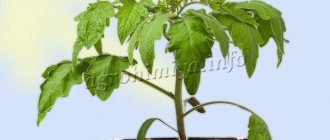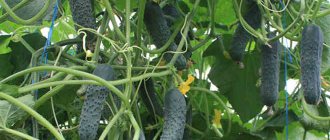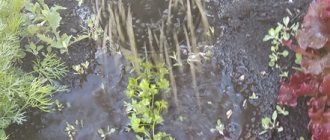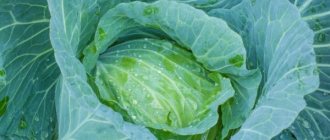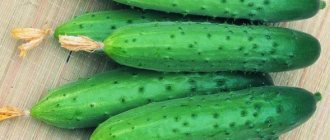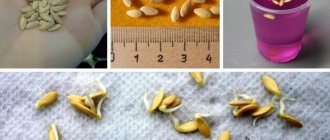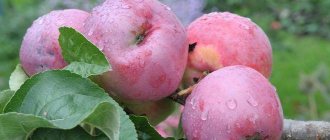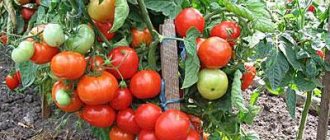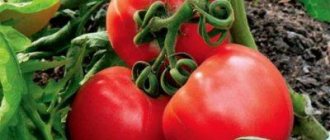Medium-early, large-fruited variety with high marketability and productivity
From planting to the first harvest, as a rule, 120 days pass.
The tomatoes are deep red, round and slightly flattened. The size is average, but some specimens grow up to 180 g. Ballad - Medium early variety. From mass germination to fruit ripening 114-116 days. The plant of the Ballada variety is determinate, compact, the height of the main stem is 45-50 cm.
The first inflorescence is formed above the 6-7th leaf. The fruits are flat-round, smooth, red, weighing 130-150 g. Contain 5.0-6.0% dry matter, 3.1-4.0% sugars, ascorbic acid 19.1-21.6%, acidity – 0.47-0.54%. The mid-early variety Ballad has high taste. It is characterized by simultaneous ripening, high yield (up to 95%) of standard fruits, good transportability and keeping quality.
The mid-early tomato variety Ballada is tolerant to the pathogens of mosaic, Alternaria and bacterial black spot. The yield of the Ballada variety is 60-80 t/ha. The mid-early tomato variety Ballad can be grown both by seedlings and without seedlings. Seedlings, as a rule, are grown through cassettes (sowing seeds in special cassettes).
The planting scheme for the mid-early variety Ballada depends on the type of soil and the type of irrigation. For drip irrigation, the most popular scheme is: 120 60 x 25-30 cm, 90 50 x 30 cm. When sprinkling irrigation, the following scheme is used: 70 x 30 cm. The Ballad tomato variety is one of the most popular tomatoes for mass production. Due to its high solids content, it is ideal for producing tomato juice and tomato paste.
|
- The shape and height of the plant is a determinate type plant, compact, the height of the main stem is 40-60 cm.
- The period from germination to the beginning of fruiting is 114-116 days.
- The fruits are flat-round, dense, large, highly transportable, smooth.
- The color of the fruit is bright red (without a green spot at the stalk).
- The average fruit weight is 130-150 g.
- Productivity - 65-80 t/ha.
- Plant density is 25-35 thousand plants/ha (depending on the selected sowing or planting scheme).
You can find recommendations for growing peppers in the “Recommendations” section - Recommendations for growing sweet peppers from the Nasco company.
* Nasko company reserves the right to make changes to current information (fractions, batches, storage dates) posted on the front side of the package or can without prior notice
Tomato variety Afen f1
Description of the tomato variety Afen f 1
Hello, dear friends! Tomatoes are a combination of taste and benefits. Few people don’t like tomatoes, because they have a unique sweetish taste, juicy structure and aromatic smell. The tomato occupies one of the most significant places in the world of vegetable crops. There are an incredible number of types of this vegetable: cherry, “cream”, ox heart, for salads and for rolling, red, pink, yellow...
Tomatoes help the cardiovascular system, are a source of the strongest antioxidant lycopene, and protect the body from toxins.
Many gardeners love to grow tomatoes, but it is not as easy as it seems at first glance. Today we’ll tell you about the tomato variety Afen f1
, which is rightfully considered one of the best for growing in amateur and professional vegetable growing.
Description of the tomato variety Afen f1
Afen f1 is a fairly common tomato variety nowadays. The hybrid was first grown by breeders from France. Often packaged in quantities of 10, 250 and 1000 seeds. This variety of salad tomatoes is used mostly fresh. But such tomatoes are also rolled up, cooked into ketchup, and added to soups and sauces. They willingly plant it in dachas in the suburbs for their own use, even in the absence of a large plot of land.
This variety is also good for specialized agricultural farms, since its cultivation
ideal for commercial purposes.
Experienced gardeners love to work with this variety. In general, reviews of the Afen f1 variety are mostly positive. The tomato is considered ideal for greenhouse cultivation.
The main advantages of tomatoes of the Afen f1 variety
1.High level of taste characteristics.
3.Excellent presentation.
4. Does not require special care.
5.Resistant to various diseases and pests.
Varietal characteristics and care
The bushes are tall, powerful, indeterminate; It is necessary to form bushes into one stem, pinching and support. Can be cultivated both indoors and outdoors.
The trunk is thick. Thick green leaves protect the fruit well from the sun and bad weather. One bush has about 10 bunches and an average of 40-50 tomatoes. The color of the fruit is from crimson to pink, the shape is round and regular.
The fruits can be classified as large (on average 200-500 grams). The tomatoes are juicy, sweet, and store well. Tomatoes of this variety ripen quite quickly (60-100 days).
The ideal temperature for seedlings is 22-23 degrees with a gradual decrease to 17-19 degrees. The most ideal time for sowing is early March. It is better to water the plants in the morning. Water only at the roots, avoiding water getting on the leaves.
In order to speed up growth and maturation, it is a good idea to remove all the leaves under the lower cluster. It is also necessary to cut off side shoots once every two weeks.
This variety is created for large yields, so these tomatoes absorb nutrients faster than simple varieties. Fertilizers required for Afen f1: potassium (strengthening the root system, responsible for long-term storage and taste), phosphorus (ripening, variety of fruits and stems), nitrogen (green leaves, bush growth). Potassium should always exceed nitrogen. You also need to support tomatoes with a fertilizer containing boric acid. When active fruit growth begins, liquid sodium humate with superphosphate is added.
Even a novice gardener with no experience in growing vegetables can harvest a good harvest of Afen f1 tomatoes. The main thing is to correctly approach the fertilization of both the soil before planting and tomatoes in general, watering, weeding, and removing excess shoots. It will also not be superfluous to study the necessary literature about technology, features, methods and some techniques for growing tomatoes.
As they say, the main thing is desire, and then your tomatoes will be juicy and tasty! See you!
How to grow tomatoes
After the seedlings have sprouted, proceed to the stage of transplanting the plants into the ground.
Landing
Prepare the beds before planting. They must be clean, free of foreign debris and other plants. It is recommended to dig up the soil in the fall and loosen it in the spring. Also make sure that the soil does not contain remnants of previous diseases. A week before planting, it is recommended to add mineral and organic fertilizers to the soil. For example, add sand and peat, and then level the soil with a rake. For disinfection, it is recommended to water the beds with hot water.
As soon as the beds are ready, proceed to transplanting the sprouts. The holes should be located at a distance of about 40-60 cm from each other. Place the sprouts in them with lumps of the old soil on the roots. When you plant the bed, water the soil with warm water. Make sure that water does not get on the leaves. It is better to plant tomatoes in the morning or evening.
Important! The final stage of planting is the installation of pegs that will serve as support for the bushes. The height of each must be at least 1 m. The bushes must be watered every 5-6 days
Pay attention to weather conditions as well. If it rains frequently, reduce the amount of water. If it's a hot and dry summer, increase it. The main thing is to remember that excess moisture leads to cracking of fruits and the development of many diseases.
It is necessary to water the bushes every 5-6 days. Pay attention to weather conditions as well. If it rains frequently, reduce the amount of water. If it's a hot and dry summer, increase it. The main thing is to remember that excess moisture leads to cracking of the fruit and the development of many diseases.
Important! The Anastasia variety is not protected from the formation of stepsons. Remove shoots carefully so as not to damage the remaining stems. Some gardeners recommend doing this with gloves.
Some gardeners recommend doing this with gloves.
Remove weeds periodically. To create the best conditions, cover the beds with dry leaves. Also, do not forget to loosen the soil every 7-10 days. As soon as the fruit begins to set, tie the stems to the stakes. Otherwise, the branches will break under the weight of the vegetables.
Don't forget about applying fertilizers. The first feeding is carried out 10 days after planting. The hybrid responds well to fertilizing based on ammonium nitrate, potassium salt, and other nitrogen-containing substances. Ordinary organic compounds, such as humus and liquid mullein, perform well as fertilizers.
Features of cultivation and possible difficulties
It is also necessary to tie up the Anastasia variety so that insects do not feast on fruits that come into contact with the ground. In addition, the garter provides the tomatoes with air ventilation between the bushes and convenient watering of the plants.
In addition to pegs for garter, you will need ribbons. It is best to use synthetic material, as it does not rot, which means it attracts less insects. It is better not to use ropes and wire for garters.
If Anastasia's leaves become dry and turn yellow, it means the plant lacks magnesium. A solution of Epsom salts or magnesium nitrate will help correct the situation. If the leaves have a pinkish tint, the bushes do not have enough sulfur. Replenish its deficiency with magnesium sulfate.
Diseases and pests
Among insects, the hybrid is most often attacked by wireworms. It penetrates the root system and destroys the roots of the bush, eating them. As a result, the bush dies, and the wireworm moves to another plant. There is also another pest called whitefly. This small insect looks similar to a white moth. The whitefly attacks the tomato in a flock, sits on the leaves and feeds on them. Spraying with whey or garlic solution helps get rid of pests.
Of the diseases, the worst enemy of all tomatoes, late blight, deserves special attention. It appears as brown spots on the leaves, which are very difficult to get rid of. The hybrid can also get blackleg.
This fungus appears as a result of soil contamination and penetrates the weakest stems. To prevent it, it is recommended to monitor the light and watering regime and loosen the soil.
The hybrid can also get blackleg. This fungus appears as a result of soil contamination and penetrates the weakest stems. To prevent it, it is recommended to monitor the light and watering regime and loosen the soil.
Care
It is important to water these tomatoes with warm water - on average, up to 4 liters per bush. To improve the formation of ovaries, it is necessary to spray with stimulants. Apply nitrogen-containing fertilizers before flowering.
A month before harvesting, it is necessary to stop feeding the plants with fertilizers. You should constantly loosen the soil around the plant, sprinkling a little bit of grass, making a small hill.
Tomatoes of the “Ballad” variety are best watered using the drip method so that the leaves are not affected by water. In this way, infection of the plant can be avoided.
Description of the tomato variety Vasilina, its characteristics and cultivation
Tomatoes are a storehouse of useful vitamins and minerals. Tomato fruits are not only healthy, but also have good taste. Most gardeners in Russia allocate at least several beds for planting. Every year, breeders add to the number of varieties, breeding more stress-resistant and productive species. The Vasilina tomato is one of the popular productive varieties, included in the state register for the West Siberian region.
General information about the plant
The tomato variety Vasilina is recommended by the originator for growing in open ground and film shelters. It is necessary to choose a place for planting based on the climatic features of the zoning. Characteristics of tomato and external features of the plant:
- An early ripening variety, the berries are harvested after 95–100 days.
- High yield, up to 495 hectares are obtained from one hectare of crops.
- Indeterminate.
- Tall.
- The height of the bush is up to 150 centimeters.
- Leaves are medium sized.
- Green leaf color.
- Medium branched.
- Semi-spreading.
- Inflorescences of intermediate type.
- Dark spot near the stalk.
- Pedicel with articulation.
- Stable immunity to most nightshade diseases.
- Stress-resistant.
- Cold-resistant.
- Good keeping quality.
- Transportability of fruits.
Reviews of the early ripening tomato Vasilina indicate successful cultivation of the plant outside its homeland. Technical data and description of fruits:
- Light green color when immature.
- Raspberry color when ripe.
- The number of nests is from four pieces.
- Maximum weight 200 grams.
- Good taste.
- No sourness.
- Prone to cracking.
- Round shape.
- High density.
- Not watery.
IMPORTANT! The yield of marketable fruits is up to 93%. Tomato belongs to salad varieties
The fruits are suitable for fresh consumption, as an ingredient for salads and stuffing. The berries are used for preparing preparations, salted and pickled. The fruit is used for processing, making purees and juice.
Tomato belongs to the salad varieties. The fruits are suitable for fresh consumption, as an ingredient for salads and stuffing. The berries are used for preparing preparations, salted and pickled. The fruit is used for processing, making purees and juice.
Growing Tips
The plant is recommended for seedling planting. You can get healthy seedlings by following a number of rules:
- Plant to a depth of 1.5–2 centimeters.
- Preliminary moistening of the soil.
- Maintaining room temperature from 21 degrees.
- Timely moistening of the soil.
- Organization of 16-hour daylight hours.
- 10 days before planting, it is necessary to harden the sprouts.
The plant is unpretentious; the originator advises planting no more than four bushes on one square meter of land according to a 50x40 centimeter pattern.
For better yield, you should follow simple rules of agricultural technology: watering with warm water, loosening the soil, removing weeds, fertilizing up to 6 times per season, tying to a trellis and installing supports. When tying, synthetic materials should be used.
Gardeners' opinion
Good day! Last summer I discovered the Vasilina tomato. The variety is unpretentious and does not require particularly close attention. Even a novice gardener can cope with cultivation. The fruits have a good taste, are not sour, and are suitable for processing. I make excellent paste with tomato pastes obtained from berries. I recommend!
Anna Claire, 32 years old
Good afternoon! I recommend the Vasilina tomato variety to everyone. The variety is very productive and not capricious. It responds well to feeding and does not like excessive moisture. The disadvantage of the fruit is its tendency to crack.
Manner
Before planting, it is necessary to make the soil looser: stir in peat and sawdust. Also, add manure that has overwintered more easily as a fertilizer, so as not to burn the roots of young shoots. It is equally important to add parasite ash and fertility mineral granules.
Seedlings must be placed according to a 40*50 centimeter pattern. In this case, there will be up to 9 bushes per square meter. And this means that the average yield of such a plot will be over 70 kilograms of tasty and ripe fruits.
Description of tomatoes
Many gardeners believe that low-growing varieties produce lower yields than tall tomato bushes. However, the Ballad is proof that such a theory is incorrect. Despite the fact that the bush takes up little space when fully grown, a large number of large fruits appear on it.
- Uniformly colored tomatoes, red, without a characteristic spot near the stalk.
- The skin of a ripe fruit is very soft and pleasant.
- Tomatoes tolerate transportation well.
The pulp of Ballad tomatoes is juicy and has a rich color. These fruits are very suitable for various types of preparations. Tomatoes are very aromatic, so they are an excellent component of salads. They taste a little sweet, but with sourness.
What attracts gardeners
Low-growing tomatoes traditionally produce less than tall tomatoes. This scares away gardeners. But Ballad is a different matter. The bush takes up little space. There are a lot of large tomatoes on it.
In the description, the authors note:
- absence of a green spot in the area of the stalk;
- rough skin;
- juicy pulp;
- bright aroma;
- sweet and sour taste;
- height < 60 cm;
- high productivity of the variety (total yield 9 kg/m²).
The first tassel is tied over the 6th leaf. Has about 5 fruits. The plant is weakly overgrown with leaves. Does not require shaping or garter.
When growing Ballad tomato in open ground, you should mulch the soil with rotted sawdust, mown and dried grass. The berries will remain clean and will not rot.
In the greenhouse, the tomatoes are stretched. The stems fall to the ground. When planting tomatoes, it is recommended to cover the bed with dark non-woven material (spunbond).
Description of the Butterfly tomato variety, its characteristics and yield
Currently, cherry tomatoes are popular among gardeners; among similar ones there is the Butterfly tomato. The description is very similar to cherry fruits, but this tomato is tall and produces a higher yield. Let's consider the qualities of Butterfly and the responses of those people who have already grown these tomatoes.
Varietal characteristics
The tomato bush is tall, mid-season and high-yielding. Determinate - grows up to 1.5 meters in height. The plant is powerful, heavily leafy; during the entire period, 3 clusters with a large number of fruits are formed on the bush. Up to 50 egg-shaped tomatoes will ripen on one branch. To get a higher yield, gardeners grow the plant in two trunks, with 3 clusters of fruit appearing on each. Thus, the yield from one plant is doubled. The yield reaches 5 kilograms if there are two branches, and accordingly the yield will increase. The ripening period from seed germination to harvest is 110–120 days. Recommended for cultivation in greenhouses and greenhouses.
When growing, the bush is tied to a support; the branches should also be fixed, otherwise they will break off under the weight of the tomatoes.
The fruits are egg-shaped and pink-raspberry in color; one fruit weighs on average 30–40 grams. They are all the same shape and size, so they look very nice in jars after seaming. The taste of the variety is good, sweet, the flesh is fleshy, the skin is thin. The fruits are suitable for processing, pickling and eating raw.
Positive traits
Judging by the reviews, the Butterfly variety has no bad qualities, only positive characteristics:
- High yield.
- High quality fruits.
- Marketable condition.
- Possibility to grow in two stems.
- Excellent taste.
- Versatility of use.
- Possibility of growing on a loggia.
Agrotechnics of cultivation
Butterfly is grown by seedlings; 60 days before planting in the ground, the seeds are planted for seedlings. Garden soil with black soil is used. The seeds are planted one centimeter deep, watered with warm water and covered with film until germination. When the sprouts hatch, remove the film and continue growing the seedlings in a well-lit place.
Tomatoes are planted in the place where parsley, dill, garlic, cucumbers or carrots used to grow. Planting pattern 50 by 40 centimeters. After planting the plants in the ground, they are cared for, which includes watering, weeding, loosening the soil, tying up and fertilizing the plants.
Landing
Before planting, you need to make the soil looser: add peat and sawdust. Also, add manure that has been overwintered better as a fertilizer, so as not to burn the roots of young shoots. It is equally important to add parasite ash and mineral fertilizers.
Seedlings must be placed according to a 40*50 centimeter pattern. In this case, there will be up to 9 bushes per square meter. This means that the average yield of such a plot will be over 70 kilograms of tasty and ripe fruits.
Tomato Ballad - description and characteristics of the variety
Description
Breeders bred this tomato for open ground. However, it can be planted in polycarbonate or film greenhouses. The ripening period from sowing is 120 days and above. The color is bright red on the outside and more pale on the inside. The fruit is quite round, slightly flattened. The average weight reaches 180 grams.
Does well in warm regions. Cooler areas require constant shelter with periodic ventilation.
The collected fruits are stored for a long time. They are convenient to transport. The fruits ripen well when picked green.
Peculiarity
A low bush makes it possible to plant up to 9 bushes on one square meter. Moreover, such a short tomato is very convenient to spin around. Quite large tomatoes grow on it. When eaten, the tomato has a quite pleasant skin - moderately thick, juicy copra and a subtle tomato taste.
The height of the bush on average does not exceed 60 centimeters. The first inflorescence appears on the sixth leaf. The bush is well formed. The trunk is quite strong and does not require garter. The ovaries are also formed quite high, so that the fruits are rarely supported, only if it is clear that there may be contact with the ground.
Sowing and germination
- It is necessary to sow seeds in a warm place, starting from Martha 15, plus 5 days. The seeds are placed in the ground, deepening them at a distance of 1 - 1.5 centimeters, but not lower. Before placing seeds in the ground, it is necessary to spill it with warm water.
- Next, at a distance of 2 or more centimeters, you need to place each seed in a trench or 2 - 3 seeds in sectional containers with soil. Then add dry soil on top and cover with black polyethylene.
- After the emergence of seedlings, you need to move the containers with seedlings to the windowsill. It's cool and bright there. If necessary, you can use a pendant or table fluorescent lamp.
Manner
Before planting, it is necessary to make the soil looser: stir in peat and sawdust. Also, add manure as a fertilizer, which has overwintered more easily, so as not to burn the roots of young shoots
It is equally important to add parasite ash and fertility mineral granules
Seedlings must be placed according to a 40*50 centimeter pattern. In this case, there will be up to 9 bushes per square meter. And this means that the average yield of such a plot will be over 70 kilograms of tasty and ripe fruits.
It is important to water these tomatoes with warm water - on average, up to 4 liters per bush. To improve the formation of ovaries, it is necessary to spray with stimulants
Apply nitrogen-containing fertilizers before flowering.
A month before harvesting, it is necessary to stop feeding the plants with fertilizers. You should constantly loosen the soil around the plant, sprinkling a little bit of grass, making a small hill.
Tomatoes of the “Ballad” variety are best watered using the drip method so that the leaves are not affected by water. In this way, infection of the plant can be avoided.
Usage
This type of ass goes well with light summer salads with cucumbers, combined with lettuce leaves and green onions. One vegetable oil and the tomato will become even tastier. You can create “Astrakhan salad” - large slices of tomato with rings of onion harrier and a little unrefined sunflower oil. Here the tomato will show itself in all its delicious glory.
This variety makes delicious pastes, sauces and ketchups.
Pomona gifts tolerate transportation well. Suitable for sale in stores and markets.
"Ballad" is a very successful low-growing variety. It has delicious weighty red fruits. Suitable for growing in industrial conditions and in garden plots.
Peculiarity
A low bush makes it possible to plant up to 9 bushes on one square meter. In addition, such a short tomato is very convenient to care for. Quite large tomatoes grow on it. When eaten, the tomato has a quite pleasant skin - moderately thick, juicy pulp and a subtle tomato taste.
The height of the bush on average does not exceed 60 centimeters. The first inflorescence appears on the sixth leaf. The bush is forming well. The trunk is quite strong and does not require garter. The ovaries are also formed quite high, so that the fruits are rarely supported, only if it is clear that there may be contact with the ground.
Usage
This type of ass goes well with light summer salads with cucumbers, combined with lettuce leaves and green onions. One vegetable oil and the tomato will become even tastier. You can create “Astrakhan salad” - large slices of tomato with rings of onion harrier and a little unrefined sunflower oil. Here the tomato will show itself in all its delicious glory.
This variety makes delicious pastes, sauces and ketchups.
Pomona gifts tolerate transportation well. Suitable for sale in stores and markets.
"Ballad" is a very successful low-growing variety. It has delicious weighty red fruits. Suitable for growing in industrial conditions and in garden plots.
Characteristics of the Far North tomato and cultivation of the variety
The Far North tomato, the characteristics and description of the variety which indicate the possibility of cultivation in cold conditions, is characterized by high productivity. The tomato tolerates low temperatures without consequences, and in a short period of time the harvest is fully produced.
Advantages of the variety
The Far North tomato variety is included in the State Register of Breeding Achievements and is intended for cultivation in open ground. Reviews from vegetable growers indicate that the plant grows and develops well in regions with cool and rainy summers with a minimum amount of sunlight.
An ultra-early ripening variety in the conditions of the North-Western region begins to bear fruit in July. Ripe fruits can be harvested 90 days after emergence. Mass ripening of the crop occurs on days 93-95.
The variety is characterized by resistance to the main types of diseases of nightshade crops. Due to the short ripening period, the tomato is not affected by late blight.
Far North tomatoes do not require removing the shoots and tying them to a support. The height of the compact standard bush reaches 40-60 cm. The plant has a strong trunk, medium-sized leaves, and simple inflorescences.
The first buds appear 1 month after the seeds hatch. The central stem stops growing after the formation of 6 inflorescences. The variety is characterized by good yield.
The tomatoes are round, elongated, with barely noticeable ribbing. The fruits are intense red in color; when cut horizontally, 4-6 chambers with seeds are observed.
The tomato has a smooth, glossy surface. The pulp of the fruit is medium dense, sweet in taste. The average weight of tomatoes reaches 50-70 g.
In cooking, the fruits are used fresh, for preparing salads, and canning. Tomato fruits are processed into juice. Due to their dense consistency, tomatoes retain their shape when cut, which is why they are often used in fresh assorted vegetables.
The harvested crop, after full ripening, tolerates transportation well over distances. Tomatoes are not prone to deformation and cracking during transportation.
Agricultural technology for growing tomatoes
Tomatoes are cultivated by seedlings. To do this, pre-prepare a soil mixture, which includes:
- turf soil - 2 parts;
- humus - 2 parts;
- washed river sand - 1 part.
To plant seeds, you can use a ready-made substrate purchased at a specialized store. The soil is poured into containers, lightly compacted and watered with warm water using a sprayer.
After planting the seeds, a layer of peat 1 cm thick is poured at a certain distance from each other. A sieve is used for uniform distribution
To ensure the successful emergence of seedlings, it is important to maintain a temperature regime of at least +16°C
At the stage of formation of 2 true leaves, seedlings are picked into separate containers. For this purpose, peat pots filled with substrate are used.
The growing process requires feeding the plants. 1 week before planting in the ground, seedlings are fed with complex fertilizers with a predominance of phosphorus and potassium.
There are 6-8 bushes per 1 m². A distance of 30-40 cm is left between plants. To increase productivity and mass ripening, bushes are planted at a distance of 50 cm from each other.
Caring for the crop involves watering with warm, settled water after sunset as needed. By mulching the soil, you can reduce the number of waterings. During the season, fertilize the tomatoes 1-2 times before flowering and ripening.
Opinions and recommendations of vegetable growers
Gardeners cultivating this tomato variety indicate increased plant resistance to blossom end and root rot. The problem of damage to the root system by diseases is typical for plants cultivated in the North.
Due to the minimal amount of heat and high humidity, water from the soil does not have time to evaporate. The variety's resistance to cold and low temperatures allows plants to be planted in the ground. Although in the first days after planting, it is necessary to insulate the seedlings by covering them with film or high-density white non-woven fiber.
Alexey Fedorov, 62 years old, Voronezh.
I grow the Far North tomato for several seasons. This cold-resistant variety tolerates low temperatures well. Therefore, I can say with confidence: “Plant the seeds directly into the ground, using glass jars as shelter.” This method allows the plant to gain a foothold in a permanent place and ensures maximum yield from the bush.
How to care
Determinate varieties require the usual care:
- sowing for seedlings from March 15 to 20;
- germination in warmth (without access to light);
- after germination, place on a cool windowsill (temperature 18 ⁰C);
- additional illumination with an agricultural lamp;
- picking in the phase of 2 true sheets;
- regular feeding with mineral complexes for seedlings;
- planting in a permanent place in May (after the last frost);
- placement pattern: 40 cm x 50 cm (9 bushes/m²);
- watering in the morning 3-5 l/plant;
- spraying with ovary formation stimulants;
- adding nitrogen before flowering;
- fertilizing with mineral complexes until tomatoes are milky ripe;
- stop adding additives a month before harvest;
- regular weeding, loosening tomatoes.
The leaf blades of low-growing tomatoes are located close to the ground. When watering, drops of water wet them. There is a risk of fungal diseases. Drip irrigation will help preserve the harvest. Moisture is supplied strictly to the root of each plant in the required quantity.
The creators of the variety took care of resistance to the main types of diseases: TMV, blossom end rot. Friendly yield of fruits with proper agricultural technology allows you to avoid the attack of late blight. Berries with a rich tomato taste are good fresh. Not rough skin, juicy pulp allow you to make delicious canned food: salads, ketchups, pastes.
Tomato has high consumer characteristics. Transportability and shelf life allow fruits to be delivered to the place of sale. The harvest is quickly sold out on the market. Ballad is recommended for growing in summer cottages and farms.
How to grow seedlings
Sowing of seeds is carried out no earlier than 60 days before planting in open ground. Only in this case can you grow beautiful, healthy, but not overgrown seedlings.
Seed preparation
Hybrid seeds do not require culling. However, it will not be superfluous to disinfect the seed material.
There are several options for this procedure:
- Place the seeds placed in a gauze bag into a weak solution of potassium permanganate;
- soak the seeds in the Fitosporin solution;
- soak the seeds in a soda solution (a teaspoon of soda per glass of water) - this procedure will not only destroy pathogens, but will also speed up the emergence of seedlings.
After disinfection, it is recommended to immerse the seeds in a growth stimulator for a day.
Attention! To prepare solutions, use settled, rain or melt water. https://www.youtube.com/embed/on8HRJ3j5_U
Container and soil
Ready-made store-bought soil for indoor plants is suitable for growing seedlings. You can also prepare the soil mixture yourself.
To do this you will need the following components:
- peat;
- compost or humus;
- turf or leaf soil;
- sand (it is best to take river sand - it is coarser).
Reference! Sand is taken in half as much as other components.
To 10 liters of soil mixture add a glass of wood ash (can be replaced with crushed chalk), as well as a tablespoon of mineral fertilizers. All ingredients are thoroughly mixed.
The substrate also needs to be disinfected. To do this, place it in the oven preheated to 100°C for 60 minutes.
As a container for planting, it is best to choose peat pots, tablets or special boxes and cassettes for seedlings.
Sowing
Small holes are made at the bottom of the planting container. After this, soil is poured there. Seeds are planted in the soil to a depth of 1 cm, with a distance between seeds of 3 cm. 3–6 seeds can be placed in peat pots, and 2–4 in tablets.
It is better to spill the soil with water in advance so as not to wash out the seeds with a stream of water. The containers are covered with film or glass and placed in a warm room. The optimal temperature for seeds is 28–30°C.
Attention! You cannot place containers on batteries. Every day the film is opened for a few minutes
When the first sprouts appear, it is removed
Every day the film is opened for a few minutes. When the first sprouts appear, it is removed.
Growing and caring for seedlings
With the appearance of the first shoots, the seedlings are transferred to a cool place with a temperature of 16–18°C. After 7–10 days, the sprouts are transferred again to a warm place with a temperature of 20–22°C; at night it should be cooler – 14–16°C.
Important! Protect seedlings from drafts. Rules for caring for seedlings:
Rules for caring for seedlings:
- Watering. The roots of tomato seedlings are delicate, so water the sprouts carefully, along the edges of the container; use a watering can without a nozzle. It is also necessary to spray the plant once a day, twice on dry days.
- Lighting. Young sprouts require a lot of light, so it is recommended to place the seedlings on a southern windowsill or loggia. If there is a lack of natural light, a phytolamp is used. The containers are rotated periodically so that the plants do not pull in one direction.
- Dive. If the seedlings are located too densely, they need to be planted immediately after the first leaves appear. The sprouts are transplanted to a depth of 3-4 cm with a distance between them of 5–7 cm. The seedlings are planted together with a lump of earth. After 20–22 days, repeat diving is carried out in a larger container.
- Feeding. 15–20 days after the first shoots, the seedlings are fed. Feeding is carried out regularly, every 10 days. You can choose ready-made complex fertilizers, or you can take wood ash, eggshells or chicken droppings.
Reference! Fertilizers are applied after moistening the soil in the morning or evening.
Growing tomatoes
This hybrid is grown through seedlings and then planted in a greenhouse. In the southern regions, open ground cultivation is practiced.
How to prepare seeds?
Self-collected seeds of the second generation produce weak seedlings and unproductive plants. Therefore, before each sowing it is necessary to purchase new seed material.
supplies seeds that have undergone complete pre-sowing preparation. Additional disinfection, growth stimulation or soaking in water is not required.
Sowing seed material
Seeds are sown between March 20 and April 5, approximately two months before planting in a permanent place. Sowing includes the following steps:
- Substrate preparation. Prepare a mixture of peat, garden turf, purchased soil with microelements and humus. The substrate for seedlings should be light and nutritious;
- Pour the resulting mixture in a 5cm layer into the planting container on top of the drainage;
- Making furrows, spraying them with “Humate” and deepening the seeds by 1-2 cm;
- Pre-emergence stage. The seeds are covered with film or glass to create a temperature of 28-30*C;
- Hardening after emergence. For 2-3 days the temperature is lowered to 16*C to activate the growth of the root system;
- Main growing period. Occurs at 20-24*C under intense lighting (12-16 hours). Seedlings need moderate watering and fertilizing once every 14 days, starting from seed spitting.
Rules for planting seedlings
Seedlings are planted for permanent residence in May, when the conditions in the garden bed meet the following criteria:
- Soil temperature – from 10*C;
- Length of daylight – at least 12 hours;
- Average daily air temperature – from 12*C;
- No threat of return frosts.
The bushes are placed in planting holes so that the height of the first leaf above the ground is 4-5 cm. To stimulate rooting, it is advisable to place 200 grams of peat and humus under each plant.
Recommended planting pattern:
- The disembarkation order is staggered;
- The interval between bushes is 40 cm;
- Row spacing – 60 cm;
- The maximum permissible planting density is 6 bushes per 1 sq.m.
Description
Breeders bred this tomato for open ground. However, it can be planted in polycarbonate or film greenhouses. The ripening period from sowing is 120 days and above. The color is bright red on the outside and more pale on the inside. The fruit is quite round, slightly flattened. The average weight reaches 180 grams.
Does well in warm regions. Cooler areas require constant shelter with periodic ventilation.
The collected fruits are stored for a long time. They are convenient to transport. The fruits ripen well when picked green.
